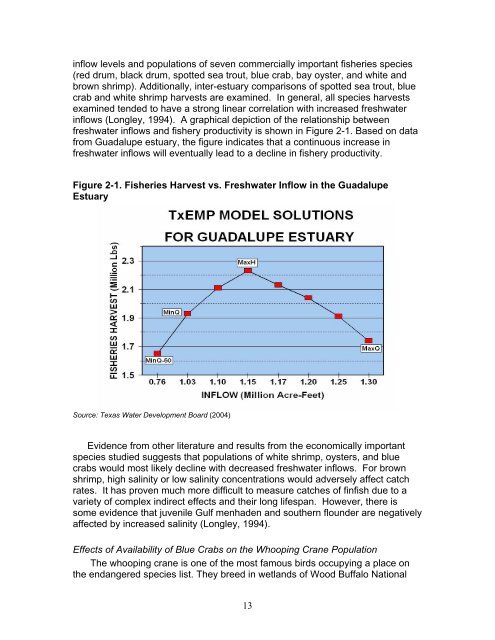The Economic Value of Water and Ecosystem Preservation
The Economic Value of Water and Ecosystem Preservation
The Economic Value of Water and Ecosystem Preservation
You also want an ePaper? Increase the reach of your titles
YUMPU automatically turns print PDFs into web optimized ePapers that Google loves.
inflow levels <strong>and</strong> populations <strong>of</strong> seven commercially important fisheries species<br />
(red drum, black drum, spotted sea trout, blue crab, bay oyster, <strong>and</strong> white <strong>and</strong><br />
brown shrimp). Additionally, inter-estuary comparisons <strong>of</strong> spotted sea trout, blue<br />
crab <strong>and</strong> white shrimp harvests are examined. In general, all species harvests<br />
examined tended to have a strong linear correlation with increased freshwater<br />
inflows (Longley, 1994). A graphical depiction <strong>of</strong> the relationship between<br />
freshwater inflows <strong>and</strong> fishery productivity is shown in Figure 2-1. Based on data<br />
from Guadalupe estuary, the figure indicates that a continuous increase in<br />
freshwater inflows will eventually lead to a decline in fishery productivity.<br />
Figure 2-1. Fisheries Harvest vs. Freshwater Inflow in the Guadalupe<br />
Estuary<br />
Source: Texas <strong>Water</strong> Development Board (2004)<br />
Evidence from other literature <strong>and</strong> results from the economically important<br />
species studied suggests that populations <strong>of</strong> white shrimp, oysters, <strong>and</strong> blue<br />
crabs would most likely decline with decreased freshwater inflows. For brown<br />
shrimp, high salinity or low salinity concentrations would adversely affect catch<br />
rates. It has proven much more difficult to measure catches <strong>of</strong> finfish due to a<br />
variety <strong>of</strong> complex indirect effects <strong>and</strong> their long lifespan. However, there is<br />
some evidence that juvenile Gulf menhaden <strong>and</strong> southern flounder are negatively<br />
affected by increased salinity (Longley, 1994).<br />
Effects <strong>of</strong> Availability <strong>of</strong> Blue Crabs on the Whooping Crane Population<br />
<strong>The</strong> whooping crane is one <strong>of</strong> the most famous birds occupying a place on<br />
the endangered species list. <strong>The</strong>y breed in wetl<strong>and</strong>s <strong>of</strong> Wood Buffalo National<br />
13
















